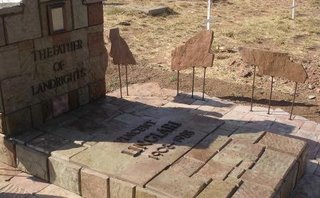
I've just come back from the twin communities of Daguragu and Kalkaringi, about 750km south-west of Darwin, the home of the Gurindji people, whose country extends an hour's drive to the east and a little further west.
More about why I was there in another post.
It's beautiful rolling savannah, emphasised by a few low hills and rocky ridges and outcrops.
One of these ridges - Wave Hill - gave its name to the cattle station whose stockmen were Gurindji.
And their struggle, which gave birth to the land rights movement in Australia, is what put it into the history books.
The station was selected in the late 1880s by old man Buchanan and up until the 1950s ran on largely unpaid Aboriginal labour.
From about the time of the First World War it was owned by the British Lord Vestey, a hugely wealthy absentee landlord.
Anthropologists Ronald and Catherine Berndt were hired by Vesteys in the late 1940s to investigate how Vestey's couild recruit more Aboriginal people into the industry.
That investigation turned into a damning report on industrial and living conditions on the Vestey stations that was shelved for more than 40 years.
It was finally published as 'End of an Era' in the early 90s.
The report, in sparse prose, related how Vesteys cruelly exploited Aboriginal workers, who were little more than slaves, working for rations - soup bones, offal, salt beef flour, sugar, tea and tobacco - and clothes.
Boys as young as 11 started in the industry and worked til they dropped.
Their health was poor and injuries went untreated.
While it is true the stations took care of dependants, they all had to do some work about the place for their short rations - children, the aged and the infirm
Many old men gimp around with broken hips, a common injury when you're on horseback around cattle.
From about the 1950s, there was a minimum wage and for many of the older men it was the first time they'd seen real money.
For others, who had worked for the Army during World War 2, it was back to the good old days.
In the 1960s the labour movement - mainly the wharfies and the North Australian Workers Union - began to agitate seriously for equal pay for Aboriginal stockmen.
The pastoralists argued vehemently against it, pointing out thaty Aboriginal stockmen weren't worth as much as whites.
And yet the industry had relied on their labour for more than half a century.
The Commonwealth Conciliation and Arbitration Commission eventually handed down its decision in 1966, proposing a gradual intriduction of equal wages over the following three years.
But the Wave Hill stockment had already had enough.
Led by Vincent Lingiari (that's his grave at the top of this post), they walked off Wave Hill station - men, women and children - and four days later camped at Wattie Creek.
It wasn't an arbitrary choice of camp.
Apart from having good water year-round, Wattie Creek is also Lawi - dreaming place for the Rainbow Serpent.
The significance of that escaped me until I visited the place last week, but it's now clear to me that a people who were believed to be fringe dwellers with no culture had all along nurtured it away from prying eyes.
Where else to go when you're turning your back on oppression?
The story of the strike is told in Frank Hardy's Unlucky Australians, a book that's as much about Frank as about the Gurindji.
Some of the srtikers went south and told of their conditions at union meetings.
Lupgna Giari, a Mudpura man, was questioned by journalists.
Surely stockmen got more than salt beef and flour? Oh yes, sometimes they bin put more salt on the beef.
But somewhere along the line, it emerged that striking for equal pay was only the tip of the iceberg, to use a geographically inappropriate metaphor.
What the Gurindji really wanted was their own land back.
The company and the government of the day tried everything to get them to go back to work.
Govenrment money eventually paid for housing at Kalkaringi, the site of the present-day community and then site then of the old Welfare rations depot.
But they sat it out.
Eventually Gough Whitlam came and poured the famous handful of sand into Vincent Lingiari's hand as he handed over the lease to the land.
They built another community at Daguragu, close to Lawi.
Early this month the Gurindji and their friends - among them Frank Hardy's son and granddaughter - joyfully celebrated the 40th anniversary of the walk-off.
There was a couple of sour notes, however.
One was the death of an old man from Daguragu.
And the other was the emergence of a revisionist history of the cattle days that asserted that the station owners were deeply saddened by the Wave Hill walk-off and all the other walk-offs that happened across Northern Australia.
They hadn't been in the interests of Aboriginal people and had forced the pastoralists into modernising their practices and employing fewer people.
That's a bit like blaming African Americans for getting equal rights and ending tghe colour bar.
But one of the the few surviving strikers had the last word.
Old and frail Hoppy Mick Rangiari - another one bearing the broken hip as a legacy of his days on the catttle - got up from his wheelchair and told the people at the celebrations; 'That Bestey been treat we like dogs'.
I'm with Hoppy Mick.
I trust the history that is in people's bones.
No comments:
Post a Comment